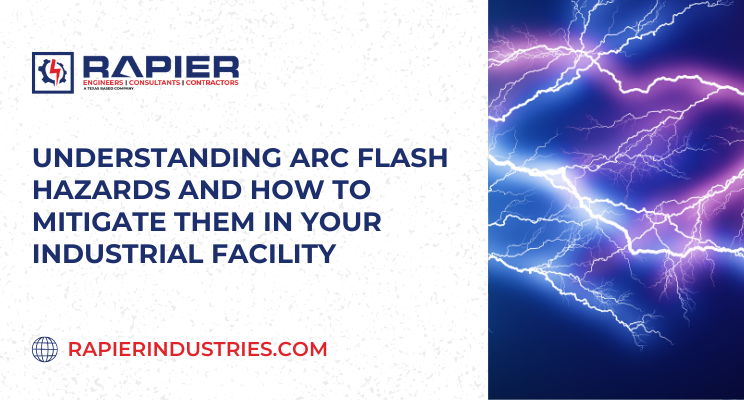In industrial environments, it’s crucial for all electrical equipment to be regularly inspected; doing this ensures that they are safe for your employees to work around and repair if need be. However, accidents can occur at any time, and the severity of these accidents can have devastating effects on both your equipment and your staff. One type of electrical hazard that facility managers and employees should be aware of is arc flash–these are considered by many to be one of the most dangerous hazards that facility employees can encounter. Let’s learn more about what arc flash is, what causes them to occur, and steps you can take to mitigate them in your industrial facility.
What Is An Arc Flash Hazard?
An arc flash hazard is an electrical explosion that’s caused by electric arcing, where large amounts of electricity move through the air between two conductors. Air is not a very good conductor of electricity, but if the air becomes ionized, electricity can travel through it and create an arc flash. Arc flashes create extreme levels of heat that can instantly vaporize objects in its vicinity; some arc flashes can reach temperatures of 36,000 degrees Fahrenheit, which is more than 3 times hotter than the surface of the sun. Arc flashes also produce blinding amounts of light, which can cause significant or even permanent vision damage to nearby people.
What Causes Arc Flash Hazards to Occur?
According to the Fire Protection Research Foundation, approximately 2,700 arc flash incidents are reported every year in the United States, and about 150 fatalities occur annually due to electrical incidents. Many arc flash hazards are caused by electrical equipment that have not been properly maintained; faulty wiring insulation and debris buildup on electrical conductors can cause an unintentional discharge to occur. Arc flash hazards can occur with low voltage, medium voltage, and high voltage electrical systems, so ensuring that all of these systems are regularly inspected is crucial to maintaining a safe working environment.
How to Mitigate the Risk of Arc Flash Hazards
The National Fire Protection Association’s NFPA 70E standards for electrical safety outlines steps that industrial facilities must take to ensure all electrical equipment is safe to work around; here are the top tips for preventing an arc flash hazard:
- Conduct risk assessments on a regular basis: Having industrial experts inspect your electrical equipment can help you discover areas for improvement and identify potential problem areas. The more frequently your equipment is inspected, the safer your facility will be.
- Have an Arc Flash Study performed: Anytime you have new equipment installed or existing equipment that has not be labeled with an arc flash label, should be a part of a facility wide arc flash study. These studies are performed by a licensed engineer and tell what the incident energy rating is at each piece of electrical equipment. A label also shows the safety radiuses needing to be maintained around that equipment and what type of electrical PPE is needed to work inside those radiuses.
- Regular Torque and Clean of electrical equipment: One of the most important things you can do is to have a time when the electrical equipment can be deenergized and all the connectors, electrical busing, and mechanical parts can be cleaned, lubricated, and re-torqued to specifications. This prevents hot spots on the gear that lead to electrical failure or even a facility fire.
- Infrared Scans of electrical equipment: The way we test for those hot spots is to perform an infrared scan of all electrical equipment while energized so these potential issues can be found before failure. Using a thermal camera, a licensed technician will go in and open all electrical gear and get photos that will then be given in a report that is read by RAPIER Industries to identify critical parts that need maintenance.
- De-energize all electrical equipment prior to electrical work: If a machine is scheduled to undergo maintenance, disconnecting it from all energy sources and following Lockout/Tagout procedures must be done first. Doing this can reduce the risk of an arc flash occurring, so making this a facility-wide practice is crucial.
- Ensure all employees wear appropriate PPE: In the event of an arc flash hazard, wearing approved PPE can drastically reduce the risk of injury. 60 CAL PPE kits are the standard for industrial environments, as they are flame-resistant and conform to NFPA 70E regulations.
If you’re looking to make your industrial facility a safer place to work by reducing the potential for arc flash hazards, RAPIER Industries can help! Our team can conduct a thoroughly-detailed arc flash study in your facility to identify potential problem areas and quickly implement solutions that address each issue. We also offer a wide range of maintenance services like IR scans and torque & cleans that are designed to increase the longevity and reliability of your electrical systems–it’s our ongoing mission to be the cornerstone of your facility’s success. Contact our team today to learn more about how we can help!


